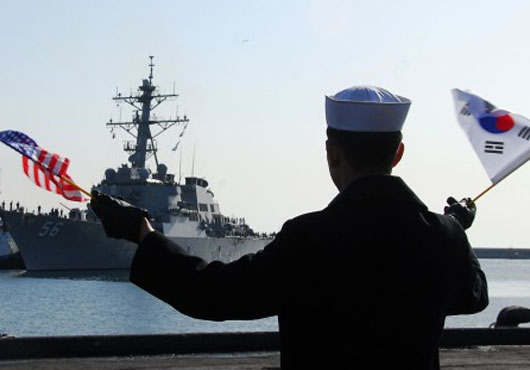 |
| U.S.-Republic of Korea Mutual Defense Treaty |
The U.S.-Republic of Korea (ROK, South Korea) Mutual Defense Treaty was signed October 1, 1953, and became effective in 1954. It committed the United States to the defense of the ROK against future attacks by the Democratic People’s Republic of Korea (DPRK, North Korea). In early 1953, as the Korean War armistice talks opened, U.S. president Dwight D. Eisenhower sought a way to convince ROK president Syngman Rhee to accept a truce with DPRK.
Rhee, who had insisted that no truce short of military reunification of the two Koreas would suffice, balked at the U.S. demand that he sign an armistice with DPRK. Rhee flatly rejected any agreement that would allow the Chinese People’s Volunteer Army (Chinese Communists) to remain in Korea following a ceasefire because he maintained that such an agreement would be tantamount to ROK’s signing its own death warrant.
Despite Eisenhower’s assurances that the United States would pursue all peaceful means of reunification, and offers to enter a mutual security pact with the ROK, Rhee sought a mutual defense treaty with the United States as a precondition for any armistice.
  |
Rhee’s unilateral release of 25,000 DPRK prisoners of war on June 25, 1953, complicated negotiations and increased pressure on the United States to bring the ROK leader to agree to an armistice. To that end, Eisenhower sent Assistant Secretary of State Walter Robinson to offer Rhee a mutual security pact and promised economic incentives in return for Rhee’s agreement.
The Robinson mission was successful, and when Rhee did not stand in the way of the armistice, which was signed on July 27, 1953, the two countries set about crafting the bilateral treaty.
On August 8, 1953, Secretary of State John Foster Dulles initiated negotiations that culminated in a treaty of six articles, based on the model of existing treaties between the United States and the Philippines, and the United States and Australia and New Zealand.
The North Atlantic Treaty Organization model was rejected because it would have given the president the authority to consider an external attack on ROK as an attack on American territory.
Seeking to limit its commitment and to contain its ally, the United States defined its responsibilities as extending only to territory under ROK control at the time the treaty was signed or subsequently recognized as lawfully incorporated into the ROK. During the ratification debates in the U.S. Senate a note of understanding was added to the treaty clarifying the U.S. position that the mutual defense agreement extended only to attacks from external forces.
It received ratification on January 26, 1954, and the president accepted the Senate’s recommendations on February 5, 1954, subject to the agreement on the limitation of commitment. ROK agreed to the change, and the treaty came into effect when ratification documents were exchanged in Washington, D.C., on November 17, 1954. The treaty remains in effect, and U.S. forces remain stationed in the ROK.